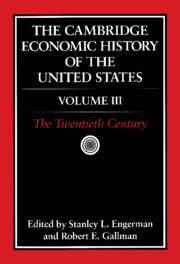Book contents
- Frontmatter
- 1 American Macroeconomic Growth in the Era of Knowledge-Based Progress: The Long-Run Perspective
- 2 Structural Changes: Regional and Urban
- 3 Twentieth-Century Canadian Economic History
- 4 The Twentieth-Century Record of Inequality and Poverty in the United States
- 5 The Great Depression
- 6 War and the American Economy in the Twentieth Century
- 7 U.S. Foreign Trade and Trade Policy in the Twentieth Century
- 8 U.S. Foreign Financial Relations in the Twentieth Century
- 9 Twentieth-Century American Population Growth
- 10 Labor Markets in the Twentieth Century
- 11 Labor Law
- 12 The Transformation of Northern Agriculture, 1910–1990
- 13 Banking and Finance in the Twentieth Century
- 14 Twentieth-Century Technological Change
- 15 The U.S. Corporate Economy in the Twentieth Century
- 16 Government Regulation of Business
- 17 The Public Sector
- Bibliographic Essays
- Index
- References
16 - Government Regulation of Business
Published online by Cambridge University Press: 28 March 2008
- Frontmatter
- 1 American Macroeconomic Growth in the Era of Knowledge-Based Progress: The Long-Run Perspective
- 2 Structural Changes: Regional and Urban
- 3 Twentieth-Century Canadian Economic History
- 4 The Twentieth-Century Record of Inequality and Poverty in the United States
- 5 The Great Depression
- 6 War and the American Economy in the Twentieth Century
- 7 U.S. Foreign Trade and Trade Policy in the Twentieth Century
- 8 U.S. Foreign Financial Relations in the Twentieth Century
- 9 Twentieth-Century American Population Growth
- 10 Labor Markets in the Twentieth Century
- 11 Labor Law
- 12 The Transformation of Northern Agriculture, 1910–1990
- 13 Banking and Finance in the Twentieth Century
- 14 Twentieth-Century Technological Change
- 15 The U.S. Corporate Economy in the Twentieth Century
- 16 Government Regulation of Business
- 17 The Public Sector
- Bibliographic Essays
- Index
- References
Summary
Government regulation of business in America has reflected a unique mix of ideas, policies, and institutional arrangements. In Europe, Japan, Canada, and Latin America, combinations of state-owned enterprise and discretionary administrative supervision were the normal forms of governmental control of business. In the United States, by contrast, semi-autonomous bureaucracies, with formalized procedures and close judicial oversight, developed detailed control over a substantial segment of private enterprise.
Government regulation in the United States has generally not been an affirmative public act, primarily because the citizenry has been so suspicious of central government authority. In political debate, proponents of regulation have felt compelled to argue that some sorts of market or managerial failure justified regulatory intervention. These include what economists call externalities (such as environmental effluents), informational problems (such as consumer-product labeling), public goods (airwaves or the banking system), the presence of natural monopoly (in which one firm has lower unit costs than two or more firms at any level of output), and anticompetitive behavior (leading to price discrimination or collusion). Yet, quite often the impetus for federal regulation came from business managers seeking to mitigate “excessive” domestic or international competition, macroeconomic instabilities, perceived structural problems (such as depleting resources), or even political interference (from state and local legislatures or popular movements).
- Type
- Chapter
- Information
- The Cambridge Economic History of the United States , pp. 969 - 1012Publisher: Cambridge University PressPrint publication year: 2000
References
- 2
- Cited by



